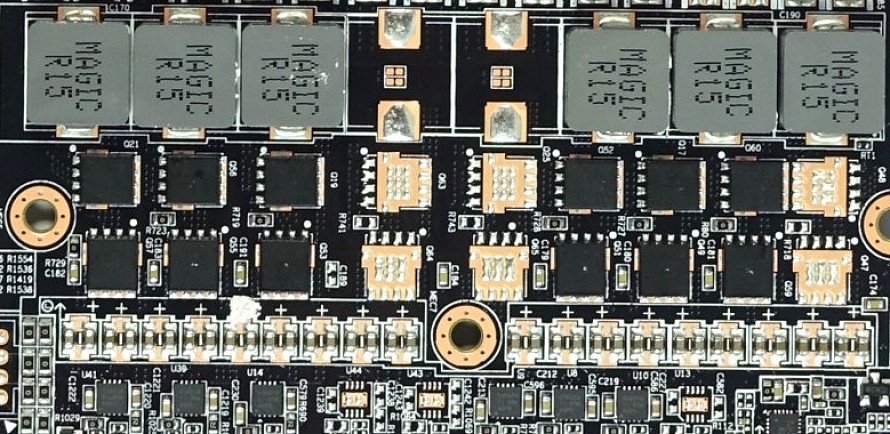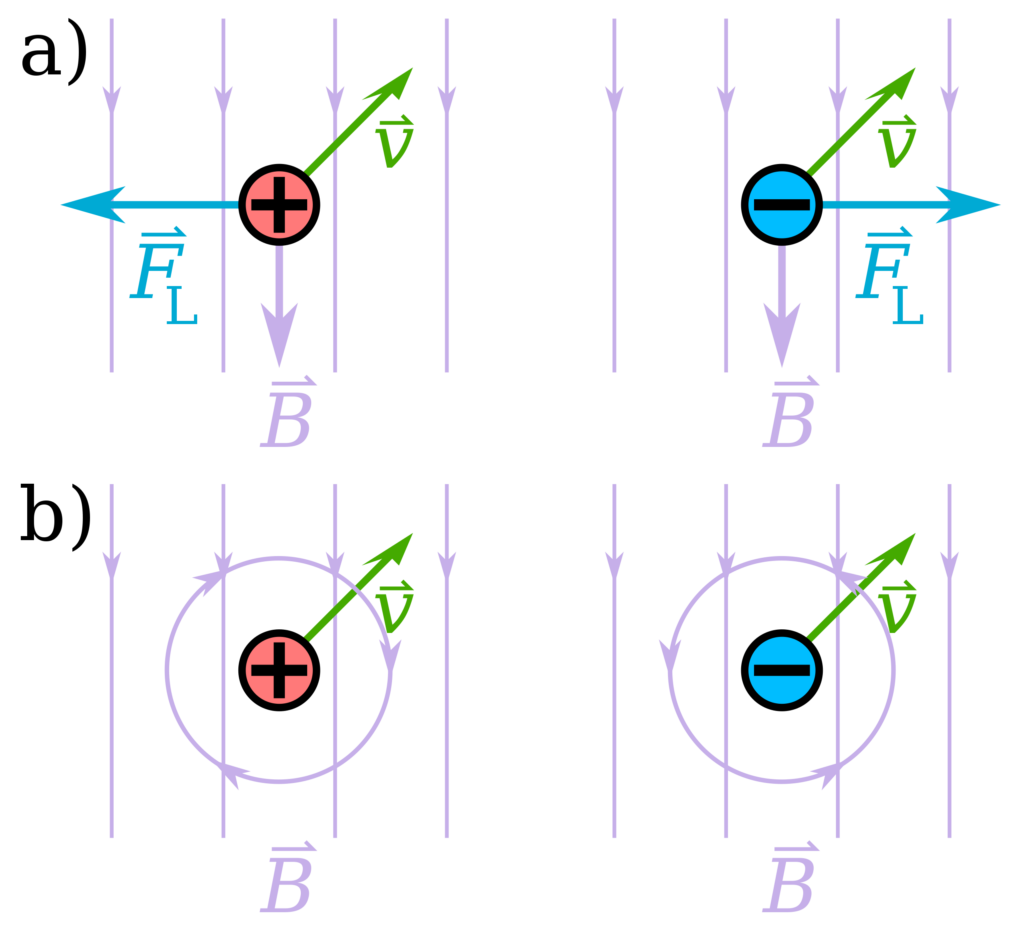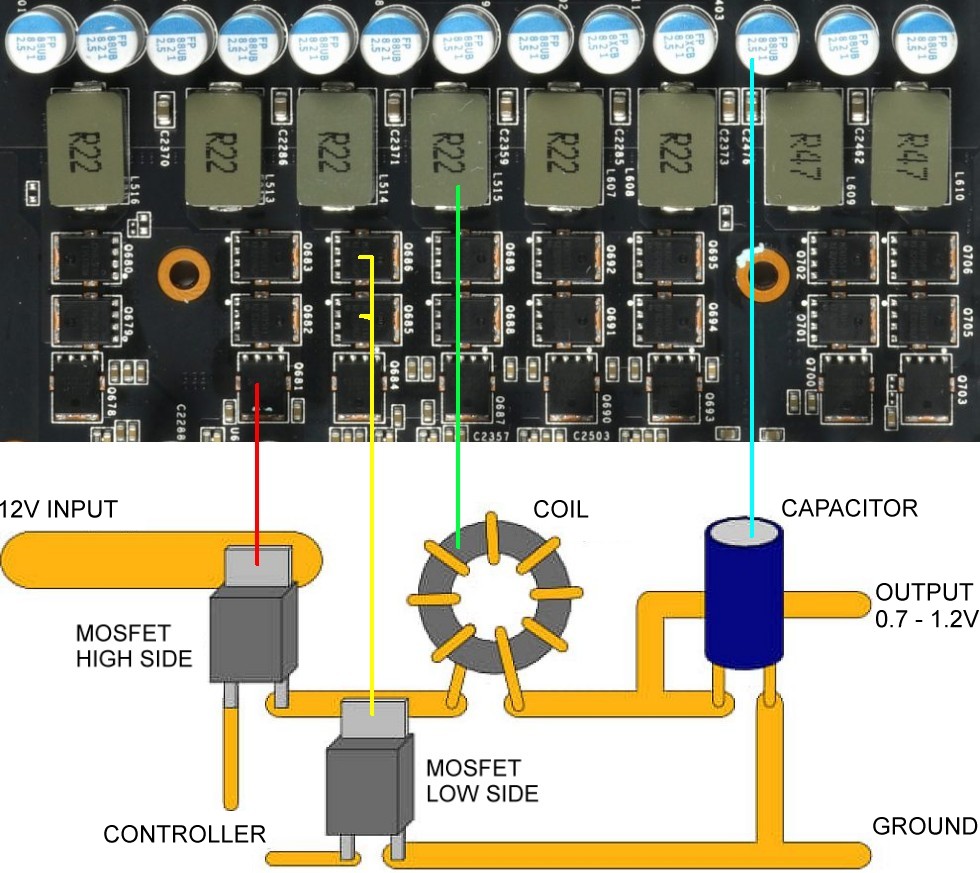The switching operation as a trigger for coil noise
For some time now, most readers have been repeatedly haunted by the same Internet ghost called Spulenfiepen, because if you are like him and actively move in the social networks or forums, you can read not only the same problems over and over again. Ok, this problem is really complex. And that is exactly why I have used a text to illustrate the switching process already briefly explained on the first page (with the kind permission of Bernhard Baumgartner), which explains in very figurative language what it is actually about and which I simply do not want to withhold from you.
I have now adapted the diagram on the first page for the control loop of such a graphics card. With this graphic you can see very simplified how a single switching regulator is built up on your board. On the low side, we use two MOSFETs connected in parallel because of the high currents. In a PWM-controlled circuit, the coil then ensures that current continues to flow even though the MOSFET is already non-conducting again (energy storage by means of magnetic field). But we already had that on the first page.
In logic, the scheme runs like this:
Gate Controller:
Now we finally need power again, kids! It cheekily sends a small control signal to the gate terminal of the MOSFET (hence the name).
MOSFET:
How awesome is that? On my gate a positive potential crawls me, I switch now times merrily Source after Drain through and become however so of conductive, let thus times fully the current through. Let’s go you cardboard noses, open the borders!
Coil:
Huh, what’n going on now? The coil, which is located behind the MOSFET, wakes up startled with sleepy eyes and checks: Oops okay, current flows through me (I get something to eat), I now have to build up a magnetic field (get really fat) as well as store the given energy, so that I can generate a reverse voltage opposite to the input voltage when needed! Because I’m something of a reflector, ugh!
Gate Controller:
OMG, what does the current evaluation tell me? A call for help? This is really too much now, because in this millisecond not so much current is needed, so please be quiet in the box! Logically, it quickly takes the control signal from the gate of the MOSFET and it shuts down again. This intelligence information, of course, comes from the PWM controller that watches over everything.
MOSFET:
I’m really pissed off now! He protestingly hangs a sign in his entryway that says: No arms, no cookies! Or also: No positive potential at the gate, no current (and drops the hammer in a huff).
Coil:
O shit, I’m about to fall asleep again! Because the coil is now also no longer flown through with current and sits on forced lean cure. And what does such a drained coil model do when anorexia becomes the center of her life? That’s right, she goes to the bathroom, sticks the wire down her throat, and pukes up all that stored energy (fat).
However, to the wrong side (i.e. not downwards)…
The counter voltage (vomit) is then fed back into the circuit at the beginning by a cleaner (diode and electrolytic capacitor) and not simply thrown away, as for example with a series resistor, because the potential can flow away to ground. Where would we end up? No! Off and back into the restaurant circuit, then tomorrow there will be delicious solyanka or goulash soup in the style of the house. Depending. So far so good. We have now also learned that nothing is lost and efficiency including recovery can also be fun ad nauseum.
Mr. Lorentz makes powerful noises
Every one of us knows it: Some people don’t even notice when they have to vomit quietly, others even have an acoustic death throes and sound like dying animals. Figuratively speaking, of course. That’s exactly how it is with coils too, they’re just people like Ulf and me. About coils, there are different designs, such as toroidal coils or capsule coils. In addition, coils often have various things in the core that affect their properties. There are iron cores (ferrite), powder cores and many more. However, an important parameter of a coil is its resonance frequency, i.e. the point at which it begins to physically oscillate. That’s exactly where the posh silencer pukes differ from the dying animals. So again figuratively.

If this frequency is within the audible range (50 Hz to 20 KHz) for the parameters acting at this time, then we perceive this as coil beeping. This is caused by the so-called Lorentz force. This describes an interaction of three physical parameters: current direction, magnetic field direction and: TAADAA: Lorentz force direction! This is exactly where the rabbit is buried in the pepper! The Lorentz direction is responsible for the mechanical movement in the coil and there is hardly any space inside. So the windings of the coil hit the case and the core, causing the coil whine, which is actually more of a coil cramp.

Let’s remember the Lorentz force and the turns rubbing against each other now, because we will need this knowledge again in a moment.




































91 Antworten
Kommentar
Lade neue Kommentare
Urgestein
Veteran
1
Urgestein
Veteran
Veteran
Urgestein
Veteran
Veteran
Veteran
Urgestein
Urgestein
Veteran
1
Veteran
1
Urgestein
Mitglied
1
Alle Kommentare lesen unter igor´sLAB Community →